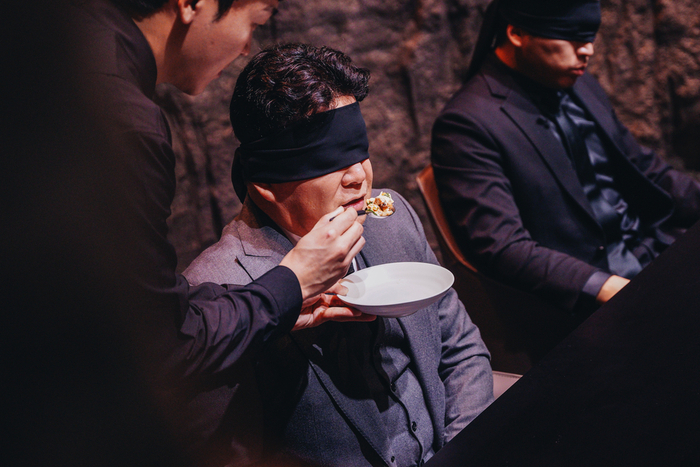
 |
| Star restaurateur Paik Jong-won, blindfolded, tastes a dish created by a contestant in "Culinary Class Wars." (Netflix) |
“Culinary Class Wars,” one of the hottest entertainment shows trending in Korea right now, offers a refreshing take on the survival show format, while highlighting the ingenious recipes created by some of Korea's most acclaimed cooks and chefs.
The competition features 100 contestants divided into two teams: the white team, consisting of the nation’s top star chefs, and the black team, made up of lesser-known cooks and local restaurant owners.
Contestants participate in a series of elimination challenges, evaluated by popular restaurateur Paik Jong-won and Michelin three-star chef Ahn Sung-jae.
Since its release on Sept. 17, the series has quickly gained popularity, securing the top spot on South Korea's Netflix chart for five consecutive days. It also climbed to ninth place among the most popular TV shows streamed globally on Netflix on Sunday, having ranked 10th on both Friday and Saturday, according to FlixPatrol.
The show's success has led to a surge of memes and parodies, with fans humorously recreating contestants' dishes and the judges' blind taste-testing moments. Even more importantly, it has led to the explosive popularity of the featured restaurants. Owner-chef Choi Gang-rok's Neo, for example, drew over 20,000 people looking to make reservations when the reservation system opened for next month's bookings, with all the available slots filled in just one minute.
The appeal of "Culinary Class Wars" stems from its unique approach to the survival program format here. Specifically, it is free of the emotional intensity commonly found in similar shows. While other Korean survival programs often rely on contestants undermining each other or scheming to eliminate rivals, the contestants on "Culinary Class Wars" exhibit a high level of mutual respect for one another’s skills and careers -- with the show emphasizing the contestant's culinary expertise as the sole criterion for advancement in the elimination rounds.
Also, the absence of controversies commonly tied to such survival programs enhances the viewing experience for those weary of the drama typical of Korean survival shows.
The decision to feature only two judges also adds a distinctive element to the program.
Most competition shows utilize an odd number of judges to facilitate majority voting. However, with only two judges, Paik and Ahn frequently have differing opinions on the same dish. These discussions spark engaging debates and offer valuable insights into their culinary philosophies and values.
The show further captivates audiences with the contestants’ remarkable creativity. In one mission, participants are challenged to showcase their cooking skills by focusing on a single ingredient. The results are visually stunning, featuring a YouTuber making ice cream with perilla oil and a star chef preparing a radish steak.
As of the fourth and latest episode, 20 contestants have been chosen from a pool of 80 black team members, and are competing to best the star chefs. The cliffhangers keep viewers eagerly awaiting the next developments.
Episodes 1-4 are available for streaming on Netflix, with episodes 5-7 scheduled for release Tuesday at 4 p.m.









